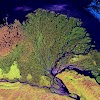Stretching from the Himalayas in the north to the Bay of Bengal in the south, West Bengal is primarily composed of plain land, except the north where the southern flank of the Himalayas extends into the state. Part of the Ganga- Brahmaputra delta constitutes the eastern part of West Bengal. From the northern highlands to the tropical forests of Sunderbans, variations in altitude result in great variety in nature and climate. Here, we are giving brief outline of West Bengal for general awareness.
West Bengal is endowed with distinct natural attractions like impressive mountain range, virgin forests, variety of wildlife, verdant tea gardens, meandering rivers, sandy beaches and the world’s largest mangrove forests, along the Sunderban delta.
West Bengal is endowed with distinct natural attractions like impressive mountain range, virgin forests, variety of wildlife, verdant tea gardens, meandering rivers, sandy beaches and the world’s largest mangrove forests, along the Sunderban delta.
West Bengal at a Glance
Capital
|
Kolkata
|
State animal
|
Fishing cat
|
State bird
|
White-throated kingfisher
|
State tree
|
Devil tree
|
State flower
|
Night-flowering jasmine
|
Neighbouring States
|
Odisha, Jharkhand, Bihar and Sikkim
|
Neighbouring Countries
|
Nepal, Bhutan and Bangladesh
|
Language
|
Bengali, Hindi, English, Nepali
|
Rivers
|
Bhagirathi, Mayurakshi, Damodar, Kongbati, Teesta, Torsha, Jaldhaka, Mahananda, Subarnarekha and Rupnarayan
|
Airports
|
Dum Dum International (Kolkata), Bagdogra, Kalakunda, Panagarh, Malda, Brrackpore, Behala, Balurghat and Coochbehar
|
Ports
|
Kolkata and Haldia
|
Fairs and Festivals
|
Durga Puja, id, Diwali, Rasajatra, Navanna, Christmas, Saraswati Puja, Vasanta Utsav, Holi and Charak. Important fairs include Gangasagar Mela, Kenduli Mela, Jalpesh Mela, Rash Mela and Poush Mela.
|
National Parks
|
Neora Valley National Park (Darjeeling), Singalila National Park (Darjeeimg), Sunderbans Tiger Reserve (South 24 Paraganas), Buxa Tiger Reserve (Jalpaiguri), Gorumara National Park (Jalpaiguri)
|
Awards and Honour
|
Biswa Bangla Sharad Samman, Banga Bhusan, Banga Bibhusan, Charu Kala Utsav, Jatra Utsav, Kolkata International Film Festival, Sangeet Mahasamman, Sangeet Samman and Tele Award
|
Historical Background
The state gets its name from the ancient kingdom of Vanga, or Banga. Around 3rd BC, it formed part of the extensive Mauryan Empire. The region was then taken over into the Gupta Empire and later came under the rule of the Pala dynasty. From the 13th to the 18th centuries Bengal was under Muslim rule, and came under British control following Robert Clive’s conquest over the region in 1757.
In 1773, Warren Hastings, the governor of Bengal, became the first Governor General of Bengal with powers over the Madras and Bombay Presidencies as well. In 1905, Bengal was partitioned into two provinces in spite of violent protests. Continued opposition to the partition led to the reunification of the state in 1911.
At the time of independence, the eastern part of Bengal became East Pakistan (later Bangladesh) and the western part became the Indian state of West Bengal. The princely state of Cooch Behar was integrated with West Bengal in 1950. The state also gained some territory from Bihar after the reorganization of Indian states in 1956.
Political Development
1905 – Bengal was partitioned into two provinces.
1911 – Reunion of Bengal 1947 – Merger of native settlement began
1956- Bengali speaking areas were transferred to West Bengal.
Culture & Tourism
The rich traditions in art and culture in West Bengal are reflected in numerous ways in theatre, folk music, literature, films and paintings. The state has seen many great writers and artists, including the Nobel prize-winning poet Rabindranath Tagore.
1. Jatra, the hugely popular theatre form, has a range of themes: from mythological to historical to contemporary.
2. Rabindrasangeet, consisting of songs written and composed by Tagore, has a strong influence on Bengali culture.
3. Bengali filmmakers—most notably Satyajit Ray, Tapan Sinha and Mrinal Sen—have also earned worldwide acclaim.
4. Popular handicrafts include leather craft, brass and bell metal, articles from bamboo and cane, clay dolls, jute products and silver filigree.
5. Handloom saris, notably the Baluchari and Dhakai, are well known.
West Bengal is ranked sixth in terms of contribution to India's net domestic product. The state's cultural heritage, besides varied folk traditions, includes notable authors in literature, including Nobel laureate Rabindranath Tagore. Kolkata is known as the "cultural capital of India".West Bengal is also distinct from most other Indian states in its enthusiasm for the sport of association football, as well as cricket, the national sport.





0 Comments